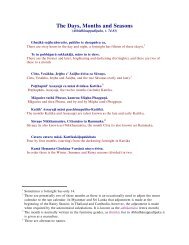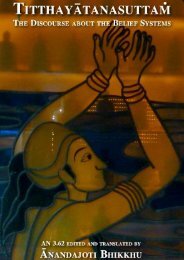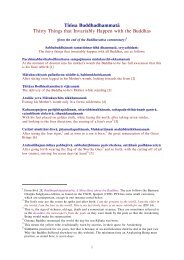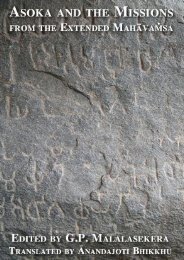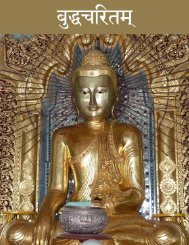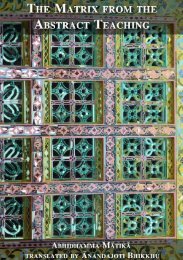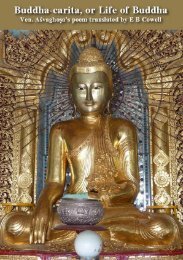The Sanskrit Text of Buddha-carita AÅvaghoá¹£a - buddhanet-de-index
The Sanskrit Text of Buddha-carita AÅvaghoá¹£a - buddhanet-de-index
The Sanskrit Text of Buddha-carita AÅvaghoá¹£a - buddhanet-de-index
- No tags were found...
Create successful ePaper yourself
Turn your PDF publications into a flip-book with our unique Google optimized e-Paper software.
Introduction to the <strong>Text</strong> - 9<strong>The</strong> pathyā form <strong>of</strong> the metre occurs in the text presented here 529 times, whichgiven that there are 593 pādayuga-s in the Śloka metre, means that it occurs in 89%<strong>of</strong> the lines, which is typical <strong>of</strong> the Classical period.<strong>The</strong>re are only 3 variations that occur in the prior line, which can be outlined here:navipulā ⏓⏓⏓−¦⏑⏑⏑− (49 pādayugas, 9%)bhavipulā ⏓−⏑−¦−⏑⏑− (7 pādayugas, 1.5%)mavipulā ⏓−⏑−¦−,−−⏓ (8 pādayugas, 1.5%)Notice that in the navipulā-s and bhavipulās-s a heavy syllable always occurs in 4thposition and at the end <strong>of</strong> the pāda. 1 In the mavipulā the opening ⏓−⏑− alwaysoccurs, and there is normally a caesura after the 5th syllable. 2 <strong>The</strong> bhavipulā lineshere always show the same opening, so that both bhavipulā and mavipulā havefixed quantities for most <strong>of</strong> the line.<strong>The</strong> metre is employed as then main metre in Chapters IV, VI, XII, and whatremains <strong>of</strong> Chapter XIV.4. Aupacchandasaka (78 Verses)In the early prosody the Aupacchandasaka was very free in its opening, theimportant thing being that it should have 6 mātrā in the opening <strong>of</strong> the prior line,and 8 in the posterior, with the ca<strong>de</strong>nce −⏑−⏑−−; over time the most popular <strong>of</strong>the openings became fixed as the only proper scheme for the metre, and inAśvaghoṣa’s prosody it is a true Addhasamavutta metre, with fixed quantities inboth lines. <strong>The</strong> scheme for the verse, which occurs in the first 78 verses <strong>of</strong> Chapter5, is as follows:⏑⏑−⏑⏑¦−⏑−⏑−−¦¦⏑⏑−−⏑⏑¦−⏑−⏑−×1 In the early period the weight <strong>of</strong> the end syllable was assured by the pause occuring inrecitation.2 12.92c shows an exception to this, as in both Cowell’s edition which reads -karma-, andJohnson’s which reads -śama-, the caesura is at the 6th.




